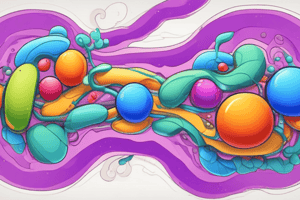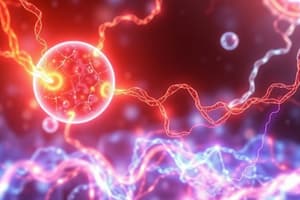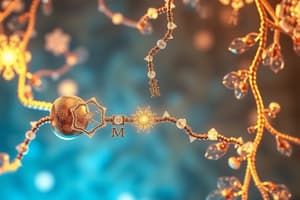Podcast
Questions and Answers
Which enzyme is primarily involved in oxidation reactions?
Which enzyme is primarily involved in oxidation reactions?
- Azoreductase
- Aldehyde dehydrogenase (ALDH)
- Monoamine oxidase (MAO) (correct)
- Nitroreductase
What is the rate-limiting enzyme in heme synthesis?
What is the rate-limiting enzyme in heme synthesis?
- Uroporphyrinogen decarboxylase
- Porphobilinogen synthase
- Heme oxygenase
- ALA synthase (correct)
Which substance is conjugated with bilirubin in the liver?
Which substance is conjugated with bilirubin in the liver?
- ATP
- UDPGA (correct)
- Coenzyme A
- NADH
What is the main product of heme catabolism?
What is the main product of heme catabolism?
Which factor does NOT affect enzyme activity?
Which factor does NOT affect enzyme activity?
What is jaundice specifically referred to?
What is jaundice specifically referred to?
Which of the following represents a condition that is necessary for high availability of energy release during biological oxidation?
Which of the following represents a condition that is necessary for high availability of energy release during biological oxidation?
Which of the following is classified as hepatocellular jaundice?
Which of the following is classified as hepatocellular jaundice?
Which shuttle system is responsible for transporting NADH from the cytosol into the mitochondria?
Which shuttle system is responsible for transporting NADH from the cytosol into the mitochondria?
Which is NOT a donor involved in conjugation reactions?
Which is NOT a donor involved in conjugation reactions?
Which compound is not considered an energy-rich compound?
Which compound is not considered an energy-rich compound?
How many ATPs are produced when one cytosolic NADH is transported into the mitochondria using the α-glycerophosphate shuttle?
How many ATPs are produced when one cytosolic NADH is transported into the mitochondria using the α-glycerophosphate shuttle?
What is the carrier molecule for NADH transport from the cytosol to the mitochondria?
What is the carrier molecule for NADH transport from the cytosol to the mitochondria?
Which statement is true regarding the characteristics of biological oxidation?
Which statement is true regarding the characteristics of biological oxidation?
What is the main purpose of NADH in cellular respiration?
What is the main purpose of NADH in cellular respiration?
What is produced during the oxaloacetate conversion in the metabolism of NADH?
What is produced during the oxaloacetate conversion in the metabolism of NADH?
What substance primarily increases in blood during prolonged starvation?
What substance primarily increases in blood during prolonged starvation?
Which molecule is crucial for ketolysis in tissues outside the liver?
Which molecule is crucial for ketolysis in tissues outside the liver?
In prolonged starvation, which energy source does the brain predominantly utilize?
In prolonged starvation, which energy source does the brain predominantly utilize?
Which enzyme is regarded as the key enzyme in the process of ketogenesis?
Which enzyme is regarded as the key enzyme in the process of ketogenesis?
Which of the following is a ketone body?
Which of the following is a ketone body?
Which compound is not involved in glycerophospholipid biosynthesis?
Which compound is not involved in glycerophospholipid biosynthesis?
What is the essential fatty acid among the following options?
What is the essential fatty acid among the following options?
Which compound serves as the raw material for cholesterol synthesis in the body?
Which compound serves as the raw material for cholesterol synthesis in the body?
What is the correct sequence of reactions in fatty acids oxidation?
What is the correct sequence of reactions in fatty acids oxidation?
Which is the rate-limiting enzyme in triglyceride degradation?
Which is the rate-limiting enzyme in triglyceride degradation?
Which hormone can accelerate fat mobilization?
Which hormone can accelerate fat mobilization?
Which enzyme is key in the β-oxidation of fatty acids?
Which enzyme is key in the β-oxidation of fatty acids?
Which of the following compounds is not generated during fatty acids β-oxidation?
Which of the following compounds is not generated during fatty acids β-oxidation?
What is the primary product of acetyl-CoA generated during fatty acid mobilization in the liver?
What is the primary product of acetyl-CoA generated during fatty acid mobilization in the liver?
In which condition is ketone body synthesis greatly accelerated?
In which condition is ketone body synthesis greatly accelerated?
Which of the following does not utilize ketone bodies?
Which of the following does not utilize ketone bodies?
Which of the following is the first substance synthesized in the de novo synthesis of purine nucleotide?
Which of the following is the first substance synthesized in the de novo synthesis of purine nucleotide?
Which of the following is the final product of purine nucleotide catabolism?
Which of the following is the final product of purine nucleotide catabolism?
Which enzyme catalyzes the synthesis of uric acid?
Which enzyme catalyzes the synthesis of uric acid?
Which substance links nucleotide synthesis directly to glucose metabolism?
Which substance links nucleotide synthesis directly to glucose metabolism?
Which of the following is not a direct material for the de novo synthesis of purine nucleotide?
Which of the following is not a direct material for the de novo synthesis of purine nucleotide?
Which of the following substances produces dNDP when reduced?
Which of the following substances produces dNDP when reduced?
Which one of the following does not inhibit the synthesis of purine nucleotide directly?
Which one of the following does not inhibit the synthesis of purine nucleotide directly?
What is the direct precursor of dTMP?
What is the direct precursor of dTMP?
Flashcards are hidden until you start studying
Study Notes
Energy-Rich Compounds
- Creatine phosphate, ATP, phosphoenolpyruvate (PEP), and 1,3-bisphosphoglycerate are energy-rich compounds.
- 2,3-bisphosphoglycerate is not an energy-rich compound.
Energy Carriers
- Malate carries NADH from the cytosol to the mitochondria.
- Carnitine, oxaloacetate, α-ketoglutarate, and aspartate are not involved in transporting NADH.
α-glycerophosphate Shuttle
- The α-glycerophosphate shuttle transports cytosolic NADH into the mitochondria, producing 2 ATP per NADH molecule
Biological Oxidation
- Biological oxidation releases energy gradually and efficiently.
- Direct combination of hydrogen and oxygen, non-enzymatic reactions, mainly occurring in the cytosol, and unregulated by circumstance are not characteristics of biological oxidation.
NADH Transport Pathway
- The α-glycerophosphate shuttle is the pathway that transports NADH produced in the cytoplasm during glycolysis into the mitochondria.
- The citrate-pyruvate cycle, Cori cycle, GSH cycle, alanine-glucose cycle are not involved in NADH transport.
Heme Synthesis
- Succinyl-CoA and glycine are the starting materials for heme synthesis.
- Ferrous iron is incorporated into protoporphyrin after assembly.
- The liver is the major site for heme synthesis.
- The initial reaction and last three steps occur in the mitochondria.
- The intermediate steps take place in the cytosol.
- ALA synthase is the rate-limiting enzyme in heme synthesis.
Heme Catabolism
- Bilirubin is produced during heme catabolism.
- Albumin transports bilirubin in the blood.
- Bilirubin conjugates with UDPGA in the liver, mainly forming bilirubin diglucuronide.
- Intestinal bacteria reduce conjugated bilirubin to urobilin, which is excreted in feces.
Jaundice
- Jaundice is a condition where the skin and sclera turn yellow due to bilirubin deposition.
- Hemolytic jaundice, hepatocellular jaundice, and obstructive jaundice are the classifications of jaundice.
Urobilinogen and Enterohepatic Circulation
- Urobilinogen is a breakdown product of bilirubin by intestinal bacteria.
- The enterohepatic circulation is a process where urobilinogen is reabsorbed from the intestines and re-excreted in bile.
Purine Nucleotide Synthesis
- IMP is the first synthesized molecule in the de novo synthesis of purine nucleotides.
- GMP, AMP, ATP, and GTP are not the first synthesized molecules in the process.
Purine Catabolism
- Uric acid is the end product of purine nucleotide catabolic metabolism.
- Urea, creatine, creatinine, and β-alanine are not the end products.
TMP Synthesis
- N5, N10-CH2-FH4 is the methyl group donor for TMP synthesis.
- N10-CHO-FH4, N5, N10=CH-FH4, N5-CH3-FH4, and N5-CH=NH-FH4 are not involved as methyl group donors.
Uric Acid Synthesis
- Xanthine oxidase is the enzyme that catalyzes uric acid synthesis.
- Urate oxidase, adenosine deaminase, guanosine deaminase, and nucleophosphatase are not involved in the synthesis of uric acid.
Connecting Nucleotide Synthesis And Glucose Metabolism
- Ribose-5-phosphate directly links nucleotide synthesis and glucose metabolism.
- Glucose, glucose-6-phosphate, glucose-1-phosphate, and glucose-1,6-diphosphate are not direct links.
Salvage Synthesis of Purine Nucleotides
- HGPRT (hypoxanthine-guanine phosphoribosyltransferase) is involved in the salvage synthesis of purine nucleotides.
- De novo synthesis of purine and pyrimidine nucleotides, salvage synthesis of pyrimidine nucleotides, and catabolism of pyrimidine nucleotides do not use HGPRT.
Materials for Purine Nucleotide Synthesis
- Glycine, aspartate, CO2, and one-carbon units are direct materials for de novo synthesis of purine nucleotides.
- Glutamate is not a direct material.
dNDP Reduction
- NDP (nucleoside diphosphate) is directly reduced to produce dNDP (deoxyribonucleoside diphosphate).
- Ribose, ribonucleoside, NM (nucleotide monophosphate), and NTP (nucleoside triphosphate) are not directly reduced.
Purine Nucleotide Synthesis Inhibition
- TMP does not directly inhibit the synthesis of purine nucleotides.
- IMP, AMP, GMP, and ADP can potentially inhibit purine nucleotide synthesis.
Azaserine Analog
- Glutamine is an analogue of azaserine.
- Serine, glycine, aspartate, and asparagine are not analogues of azaserine.
IMP and UMP Common Material
- Ribose phosphate is the common material for IMP and UMP synthesis.
- Asparagine, glycine, methionine, and one-carbon units are not common materials.
dTMP Precursor
- dUMP (deoxy-uridine monophosphate) is the direct precursor of dTMP (deoxy-thymine monophosphate).
- Other molecules related to dTMP synthesis are dUDP (deoxy-uridine diphosphate) and dUTP (deoxy-uridine triphosphate).
Studying That Suits You
Use AI to generate personalized quizzes and flashcards to suit your learning preferences.





